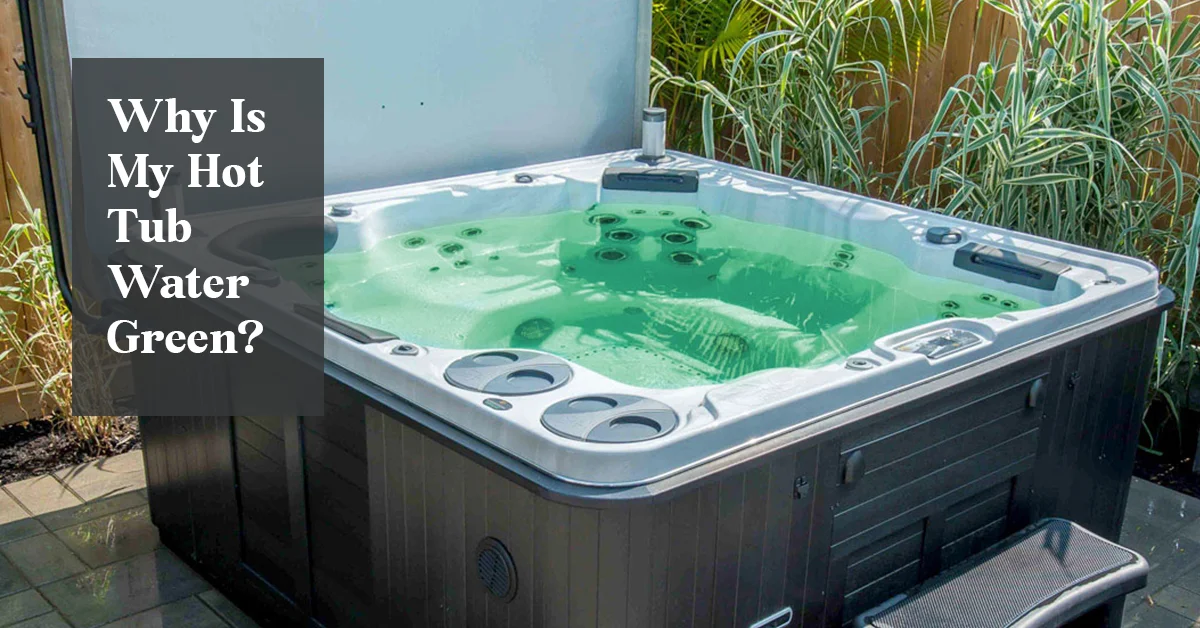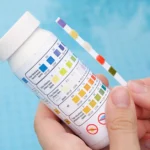Finding your hot tub water has turned an ugly shade of green disrupts a leisurely soak quite like this. You’re not alone in asking why your hot tub water appears green. Understanding the several reasons of green hot tub water—from algae growth to chemical imbalances—helps you to first bring your spa back to its crystal-clear state.
Not just looks—but also your health and safety depend on maintaining appropriate hot tub water hygiene and adhering to a regular hot tub maintenance schedule. Green water frequently points to underlying issues that can house dangerous bacteria and make soaking uncomfortable. We will investigate every conceivable source of green spa water in this all-inclusive guide and provide you tested remedies to get your hot tub back to perfect condition.
Typical Origins of Green Hot Tub Water
Implementing the correct solution depends on knowing what causes your hot tub water to go green. Let’s look at the most often occurring offenders of this annoying issue.
Algae Development: Main Agent
Among the most often occurring offenders causing green water in hot tubs are algae. These microscopic creatures flourish in warm, wet surroundings, hence when the conditions are correct, your hot tub is a perfect place for reproduction.
Indices of algal invasion include:
- Slippery or slimy textures on floor and hot tub walls
- Clearly visible green particles floating in the sea
- Musty or earthy smell
- Cloudy or foggy murky hot tub water
- Green films running alongside the shoreline
Usually when sanitiser levels are too low, pH is off-balance, or the hot tub isn’t used often enough to keep healthy circulation, algae results.
Metal Contamination: The Silent Danger
Particularly if the water source is well water, iron or copper in hot tub water can discolour the water. Many hot tub owners confuse the unique green or blue-green tint produced by oxidising these metals for algae.
Usually occurring causes of metal contamination:
- Well water heavy in minerals
- Broken heating elements or metal parts
- Poor water quality or chemical additions
- Older systems of plumbing with copper pipes
- Acidic water conditions encouraging metal leaching
The main distinction between metal pollution and algae is that metal-caused green water usually lacks the slimy texture connected with algae development and is more homogeneous in colour.
Chemical Imbalance: The Basis Issue
Often green spa water results from improper pH levels or low sanitiser levels (bromine or chlorine). Chemical imbalances not only aggravate metal pollution problems but also provide the ideal habitat for algae development.
Important chemical values to track:
- pH range: Should stay between 7.2 and 7.8
- Perfect range of 80–120 ppm is total alkalinity
- For chlorine, sanitiser levels range from 3 to 5 ppm; for bromine, same range
- Most hot tubs have calcium hardness between 150 and 300 ppm
Your hot tub becomes susceptible to many water quality problems, including green water discolouration, when these levels stray from their ideal ranges.
Method of Problem Diagnosis
Finding the source of your green hot tub water is crucial before starting any fixes. Use these methodical procedures to find the problem.
First Step: Algae Visual Inspection
Starting with a close visual inspection of your hot tub:
Look for:
- Slimy or slippery surfaces on flooring, chairs, and walls
- Green rings or accumulation point to algae development
- Algae gathering in filters and jets
- Cloudiness accompanied with green colouration
Second step is thorough water testing.
Check all important criteria with a trustworthy water testing kit:
- pH levels
- Sanitizer concentration
- Total alkalinity
- High values of total dissolved solids (TDS)
- Calcium hardness
Pro tip: Test your water always after heavy use or chemical addition at least twice a week.
Third step is assessment of metal contamination.
Look for metal in hot tub water using:
- Specialized test strips for copper and iron
- Visual hints:
- Rust-colored stains = iron
- Blue-green stains = copper
- Test your fill water if using well water
- Consider lab analysis in ongoing problems
Fourth step: evaluate the filters.
Look over your hot tub filters closely:
- Visually inspect every filter cartridge
- Search for slimy accumulation or green discolouration
- Check for appropriate water flow
- Note any odd smells from the filters
How to Correct Green Hot Tub Water?
Once the cause has been found, let’s apply focused remedies to bring your hot tub water back to absolutely clear state.
Solution 1: Stopping Algae Development
Apply this thorough treatment process:
The first action steps are:
- Shock the hot tub
- Use chlorine or non-chlorine shock oxidiser
- For extreme algae, use 2-3 times the dosage
- Ensure good circulation
- Allow 24–48 hours
Thoroughly brush every surface:
- Scrub floor, seats, walls, jets, and fissures
Sort or replace filters:
- Remove all filter cartridges
- Clean or replace if polluted
- Run hot tub without filters for initial treatment
Continuous Prevention of Algae:
- Maintain constant sanitiser levels
- Shock weekly or after heavy use
- Ensure proper water movement
- Cover the hot tub when not in use
Second solution: Tackling Metal Pollution
Use these focused remedies:
Right away treatment:
- Including a metal sequestrant
- Choose a premium metal neutraliser
- Use correct dosage
- Allow 24 hours
- Change both pH and alkalinity
- Raise pH to 7.6–7.8
- Ensure ideal alkalinity
- Consider partial or total water replacement
- If metals are high
- Test fill water
- Use pre-filter for well water
Long-term metal preventative action:
- Always test fill water
- Use water softener
- Frequently inspect equipment
- Use quality chemical brands
Third solution: Restoring Chemical Equilibrium
Use these techniques:
pH Modification Strategy:
- To reduce high pH (>7.8):
- Gradually add pH decreaser (sodium bisulfate)
- Retest after 30 minutes
- Continue until 7.2–7.6
- To raise low pH (<7.2):
- Add pH incrementer (sodium carbonate)
- Mix well
Level of Sanitation Restoring:
- For chlorine systems:
- Add chlorine to 3–5 ppm
- Use stabilised chlorine outdoors
- Weekly shock with unstabilized chlorine
- For bromine systems:
- Maintain 3–5 ppm
- Use bromine pills in floating dispensers
- Shock with non-chlorine oxidiser or chlorine
Alkalinity Balance overall:
- Target range: 80–120 ppm
- To raise: Add sodium bicarbonate
- To lower: Aerate water gently + pH reducer
How to Avoid Green Hot Tub Water?
Always better than treatment is prevention. Use this thorough maintenance schedule.
Daily Repair Activities
- Visual check of water clarity and colour
- Always cover hot tub
- Shower before entering
Weekly Maintenance Schedule
Water Balance and Testing:
- Test alkalinity, sanitizer, pH
- Adjust chemicals
- Record in maintenance log
Filtering:
- Rinse filter cartridges
- Rotate two filter sets
- Deep clean filters monthly
Shock Treatment:
- Shock with suitable oxidiser
- Run pumps
Surface Cleaning:
- Wipe waterline
- Clear visible mess
- Tidy skimmer baskets
Advanced Troubleshooting: When Typical Fix Not Working
Eliminations of Biofilm:
- Use biofilm removers
- Deep clean plumbing lines
- Consider pro system flush
- Change filters after
Problems with Circulatory System:
- Check flow rates/pumps
- Ensure all jets working
- Replace or clean pump
- Adjust valve placement
Chemical Oppensity:
- Use varied sanitizers
- Try spa-specific algaecides
- Reduce circulation temporarily
- Consider UV or ozone
When Should I See a Professional?
Explicit Signs of Professional Service:
- Persistent green water
- Equipment failure
- Recurring issues
- Safety concerns
- Complex chemical imbalances
Advantages of expert hot tub water maintenance:
- Detects minor issues
- Uses pro-grade tools
- Preventative maintenance
- Maintains warranty
- Long-term routines
Selecting the correct service provider:
- Certified spa/pool experts
- Read reviews
- Check licensing and insurance
- Ask about maintenance plans
Economical Green Water Alternatives
Costs for DIY Treatment:
- Test strips: $15–25
- Shock therapy: $20–30
- pH adjusters: $15–20
- Metal sequestrant: $25–35
- Filter cleaner: $10–15
Expert Service Purchase:
- One-time: $150–300
- Monthly: $100–150
- Annual contract: $800–1,200
Environmental Issues and Green Choices
Natural Substances:
- Mineral sanitisers
- UV sterilisation
- Ozone generators
- Enzyme-based cleaners
Water preservation:
- Extend water life
- Recycle spa water if possible
- Upgrade to efficient systems
- Use smart dosing tech
Technology and Creativity in Hot Tub Water Treatment
Advanced Monitoring Systems:
- Wi-Fi controls
- Auto-dispensing systems
- App tracking
- Alert systems
Advanced Filtering:
- Multi-stage filters
- Antimicrobial cartridges
- Long-life filters
- Self-cleaning systems
At Last
Handling Green Hot Tub Water
At last, handling green hot tub water shouldn’t be daily torture. Knowing the basic causes—chemical imbalances, metal contamination, or algae growth—you may apply focused treatments to bring your spa back to perfect state.
Remember that usually treatment costs more than prevention. Following high hot tub hygiene standards, routinely testing water, and maintaining appropriate sanitizer levels can help you to keep your water brilliant and ready for use.




